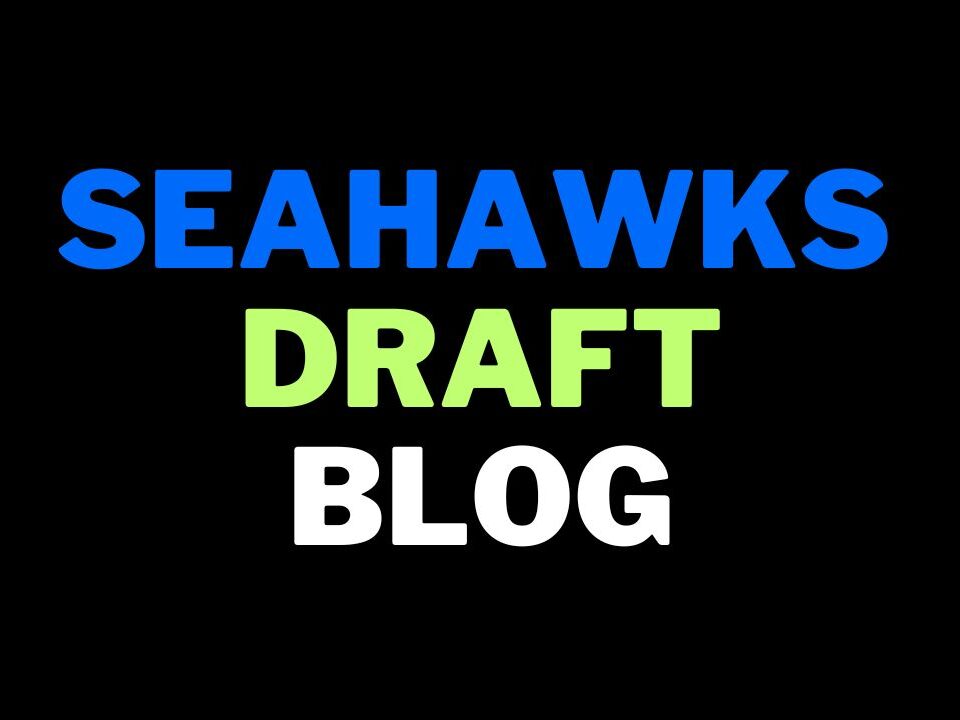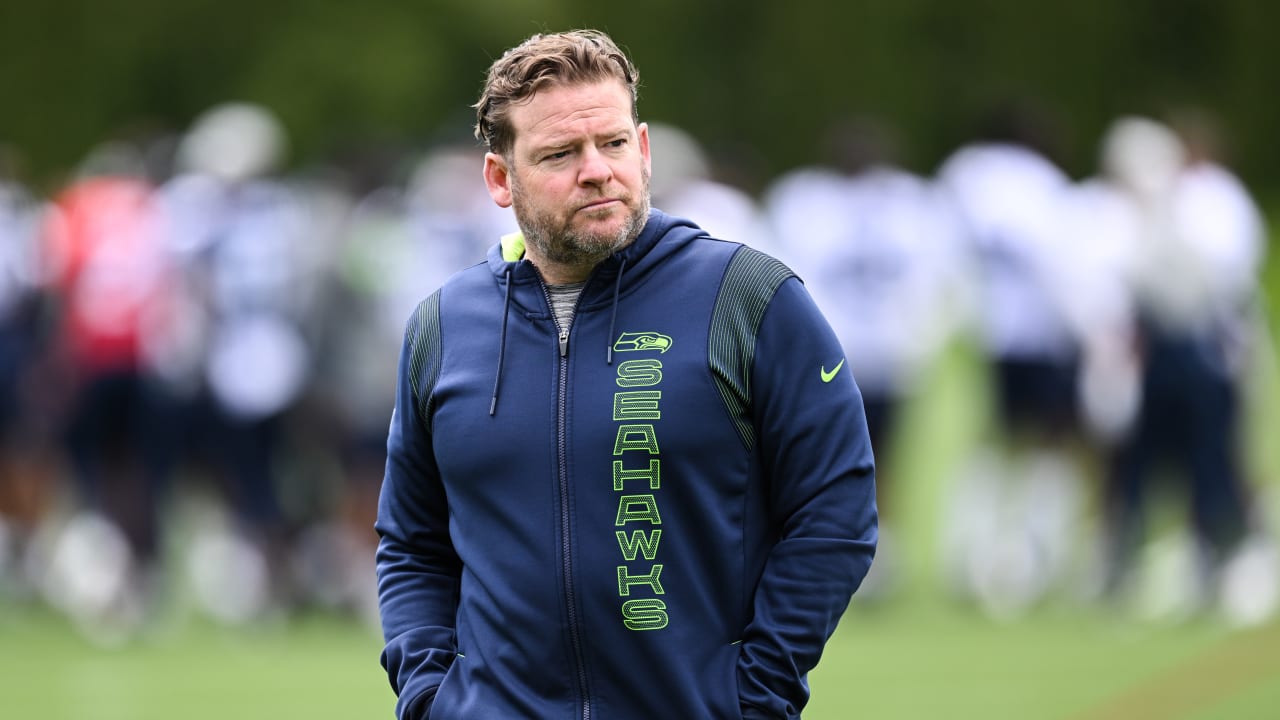/cdn.vox-cdn.com/uploads/chorus_image/image/73081884/1897614701.0.jpg)
Let me be clear, I’m a fan of Mike Macdonald’s. He speaks with a real authority during interviews and there are no wasted words. He’s succinct, his messaging is clear and there’s no doubt he’s a good communicator without needing to speak like Mel Gibson in Braveheart.
You can see he’s having a positive impact on a Ravens defense that ranked #1 per DVOA. Baltimore became the first defense in NFL history to lead the league in points allowed, sacks and turnovers this season. Macdonald absolutely is the kind of candidate the Seahawks should be talking to, picking his brains, seeing what his broader vision is and considering whether or not he should be the Head Coach for the next era of this franchise.
But I’ve noticed in recent days that Seahawks fans and media have started to go a bit too far. Macdonald’s reputation is taking on a life of its own. I’ve seen the words ‘defensive wunderkind’ used. People are saying he’s the antidote to ‘McShanahan’. Really? As we’ll see, the statistical evidence doesn’t back that up. All the while it’s being ignored that the structure of the Ravens, crafted over two decades, has enabled coordinators to be swapped in and out with little drop-off in performance.
Did you know that in the last 27 seasons, the Ravens have been the #1 ranked defense per DVOA five times and they were ranked in the top-10 every year between 1999 and 2011? There’s been a consistent run of success, irrespective of who the defensive coordinator is.
It’s also pretty clear that the Ravens benefit from having the NFL MVP quarterbacking their team. Lamar Jackson has been a revelation this season, earning a 90.9 PFF grade. We’ll come on to just how effective Baltimore’s offense has been in a moment — because it’s helped the defense in a way that has to be seen to be believed.
Firstly though, let’s fact-check some things about Macdonald and his ability to push back against Kyle Shanahan and Sean McVay.
Here’s how Baltimore’s defense faired against the Rams:
— 410 total yards conceded
— 6/16 third down
— 31 points conceded
— 128 rushing yards
— 34:35 TOP
— Zero turnovers
This was a game played in Baltimore, won in overtime 37-31 thanks to a kick-return walk-off touchdown. The Rams really should’ve won this game, despite a fairly typical offensive performance from Lamar Jackson and the Ravens’ offense (449 total yards).
Baltimore’s defense and their inability to get an angle on McVay and Matt Stafford almost cost them a win and contributed very little to a victory spurred by the offense and special teams.
Now let’s look at Baltimore’s impressive 33-19 win against the 49ers and how they handled Shanahan’s offense:
— 429 total yards conceded
— 6/14 third down
— 121 rushing yards
— 6.7 yards per rush
Again, it’s not exactly a reassuring set of statistics. These are the kind of stat-lines we’ve come to expect from the Seahawks against the Rams and Niners.
Baltimore won the game in Santa Clara mainly due to four Brock Purdy interceptions. You can watch them all by clicking here. Two are bad Purdy mistakes, two involve a large slice of turnover luck:
Interception #1 — A bad read from Purdy, not doing enough to hold Kyle Hamilton away from the intended target and throwing into a dangerously tight window that was easy to undercut.
Interception #2 — A batted pass at the LOS which wildly lands right into the hands of another pass rusher at the opposite end of the line.
Interception #3 — Purdy does his best Russell Wilson impression to scramble away from trouble, throws into tight 1v1 coverage and the ball is deflected up into the air and picked off on the rebound by another Ravens defender.
Interception #4 — An inaccurate throw by Purdy going to Christian McCaffrey, right into the hands of a grateful Patrick Queen.
To be fair, the Ravens’ defense was flying around all night and that no doubt flustered Purdy and led to mistakes. It should be acknowledged, though, that Shanahan moved the ball pretty much at will in the game and avoidable turnovers cost San Francisco. Lamar Jackson was also superb on the night.
Now let’s look at some other examples. The Ravens hammered the Dolphins a few weeks ago 56-19. I’ve seen this game used as an example of a Shanahan disciple in Mike McDaniel being ‘shut down’ by the Ravens’ defense. Miami still recorded 375 total yards and ran for 154. They were 6/15 on third downs. Why did the Ravens blow them away? Lamar Jackson. He had five touchdowns passes, over 350 total yards and was a relentless scoring machine. The scoreboard pressure applied was immense. McDaniel and his Shanahan-esque offense, though, still moved the ball.
The two teams also played in 2022, with Miami winning 42-38 in Baltimore. McDaniel’s offense produced 547 total yards, were 7/11 on third downs and Tua Tagovailoa had six touchdown passes. Again, there was very little pushback against the Shanahan scheme.
Remember when the Seahawks beat the Browns this season? Two weeks later, that same Cleveland team went to Baltimore and beat the Ravens 33-31 with a barely healthy Deshaun Watson limping around at quarterback. They won by running for 178 yards and going 8/16 on third downs.
There’s a bit of a common theme here — the Ravens not defending the run very well. They gave up 4.5 YPC on the season, the ninth highest average in the NFL. Their 109.4 YPG average ranked 19th highest, so just above average for the league.
None of this really speaks to a formula that can consistently shut down the 49ers and Rams.
Now in fairness, over the course of the season Baltimore’s opponent third-down conversion rate (36.26%) ranked sixth best in the league. As we see above though, they weren’t too clever against the Shanahan/McVay systems in this area.
It’s also a lot easier to play great defense when your offense stacks up points, applies weekly scoreboard pressure and can tee-off. That is what the Ravens do because of the brilliance of Lamar Jackson.
Curtis Allen pulled out a great statistic to highlight this advantage for Baltimore’s defense. The Ravens’ defense had a remarkable 88 total snaps this year when trailing. They barely played any time at all without a lead, in the entire 2023 season. Baltimore’s offense ranked top-five in first, second and third quarter scoring as well as time of possession. They had 193 snaps when tied to go with the 88 when trailing, compared to the defense playing 831 snaps when ahead. This is unprecedented.
Now, maybe it’s possible for the Seahawks to similarly create an offense that can achieve all of this, rank fourth in DVOA and produce the NFL MVP in 2024 or beyond? Until that happens though, you won’t be creating the kind of environment where Macdonald’s defense thrived this season.
A shout-out too to blog commenter Peter who highlighted another statistic of note. From 2003-2023, the Ravens have only had four seasons where they didn’t rank in the top-10 for defensive points allowed. Within that 20-year span, they were in the top-five 14 times. Since Lamar Jackson was drafted, there’s only been one season where the defense didn’t rank in the top-five in points allowed — and that was a year where he only played 12 games.
There are two things to take from this. Firstly, we shouldn’t underestimate the impact of having a phenomenal quarterback who helps the Ravens score points quickly with explosive plays, manages the offense like a more traditional QB when required yet can also be an incredible playmaker as a runner. Jackson is basically what everyone hoped Michael Vick would be, and then some. He’s going to be a two-time NFL MVP in a few weeks and possibly a Super Bowl winner. If he wins a ring, he’ll be on a Hall-of-Fame trajectory.
Secondly, the Ravens have done a tremendous job building a defense whoever the coordinator is. From Rex Ryan to Chuck Pagano to Dean Pees to Wink Martindale and now Mike Macdonald. They’ve all enjoyed success. Yet aside from Ryan’s fleeting purple patch with the Jets, neither he nor Pagano enjoyed lasting glory as a Head Coach. Let’s put it this way, if Macdonald departs Baltimore — it’ll be a safe bet that their defense will continue to excel.
The Ravens are a unique animal. We should probably talk about this more. They haven’t always been an amazing team — but they have consistently been able to build a roster that fits a certain style and image. Ozzie Newsome was the architect of identifying ‘what is a Raven?’ and his chosen heir — Eric DeCosta — has carried it on. The results speak for themselves.
This has enabled Baltimore to consistently produce a strong defensive brand of football, a running game and they’ve done a good job drafting for the quarterback position (Joe Flacco won a Super Bowl as the 18th pick in round one, Jackson may win one as a former 32nd overall pick).
That’s not to take anything away from the coordinators, who still need to bring everything together. The point is though, there are a lot of moving parts within the greater Baltimore machine. Can you plausibly take one part of that machine, have it shipped to Seattle and transfer the successful formula? Can anyone truly copy ‘what it means to be a Raven’ and apply it to their own structure? Or do you have to try and work out your own style and identity?
Not enough time has been spent wondering if Macdonald is a system coordinator, ideally suited to working within the structure he’s been brought up in. That might sound harsh but it’s an inconvenient topic we should broach if he’s going to lead the next era of Seahawks football. Can you take him out of Baltimore and transfer it to Seattle with the players and situation he will inherit? Or is he a young coach working in an ideal environment to succeed, with everything in place — a great front office making excellent personnel decisions, an experienced Head Coach and staff in support, a brilliant quarterback aiding the defense by scoring so many points. It’ll be different in Seattle.
This warrants some contemplation, yet at the moment the feeling around Macdonald is more one of wanting the trendy new, young coordinator on the team who is doing well without really digging into whether this is a Macdonald thing, a Ravens thing, a Lamar thing or — most likely — a bit of everything.
Then there’s another dilemma to consider. Who’s going to be Macdonald’s offensive coordinator? This is a key question. The Seahawks will not become a great team without the right caliber of play-caller and quarterback for the long haul.
Robert Saleh was similar to Macdonald a few years ago — a trendy young coordinator hire who benefitted a lot from the Shanahan offense and stars on defense. Once he was given the main job, what happened? His defensive output translated but very little else has. The Jets have a good defense every year but they’re hopeless on offense. They’ve fired one offensive coordinator, seen a quarterback drafted #2 overall bust, ended up trading for Aaron Rodgers and they’re going to spend the next off-season scrambling to put a functioning offense together.
The Seahawks will do well to be as dysfunctional as the Jets and they have better pieces on offense. But it goes to show that a team, even with a good defense, tend to only be as good as the offensive play-caller and quarterback. After all, it’s not just the Jets. The Patriots, Raiders and Jaguars all ranked in the top-10 for defense per DVOA. All struggled on offense and had disastrous seasons.
It’s also worth noting, interestingly, that nine of the 13 highest ranked defenses started last season without a defensive-minded Head Coach. Only three of the 13 highest ranked offenses had a non-offensive mind in charge.
Macdonald has only ever worked for the Harbaugh’s in Michigan and Baltimore. What is his contact list like? How is he going to compete with Jim Harbaugh as he puts a staff together in LA? Who can he take from Baltimore, given John Harbaugh will likely seek to promote from within if he loses his defensive coordinator?
Is the plan to try and coax Mike Kafka to ask for his release from the Giants to be offensive coordinator? I guess that might work. Maybe. But if it’s not him, what are the other options? At a time when Shane Waldron was snapped off the market straight away, Kliff Kingsbury is getting a good look by multiple teams and Chip Kelly’s name is seriously doing the rounds — there aren’t many good options to bring in as a coordinator. If you find someone who succeeds, you also run the risk of losing them straight away and having to go through the whole process again.
I’ll say it again — this isn’t something that ever seems to get talked about amid all the ‘get Macdonald to Seattle pronto’ chatter online.
The situation won’t be helped, either, by the fact the Seahawks have to wait until February 12th to even have an introductory meeting with Macdonald. That’s a long time to wait to find out how much shared interest there is in the position, whether visions mesh and whether you think this is the right direction to take. By the time the Super Bowl has finished, are you left sifting through the remaining available staff? What if the Ravens lose the Super Bowl if they get there and he has a change of heart and opts to stay put to finish the job?
All of this probably sounds like I’m anti-hiring Macdonald. Again, I’m not. I feel like I have to talk about these things because nobody else seems to want to. I think he comes across well, his players are clearly very organised, the Ravens might win the Super Bowl and he would’ve played a key role in that.
However — all of the context above in this article also matters.
My preference has been the same from the moment Pete Carroll was fired. Rightly or wrongly, the Seahawks have built their team around offensive skill players. They’ve paid the likes of D.K. Metcalf and Tyler Lockett huge salaries, they’ve used high picks on Jaxon Smith-Njigba, Ken Walker and Zach Charbonnet and if Geno Smith is retained, he’ll possibly be earning $31.2m next year.
Rather than say, ‘well the offense is fine, find a defensive coach’ — I’d rather focus on maxing out the production of the weapons you have. The Seahawks should be getting more out of the likes of Metcalf. They should be trying to do what the Ravens are doing — outscore opponents and apply pressure. They have the personnel to do it.
We’ve seen how Metcalf and co. underachieved under a defensive Head Coach. I want to see the kind of production Amon-Ra St. Brown, Sam LaPorta, Jahmyr Gibbs and David Montgomery are enjoying in Detroit. We’ve tried the defensive route for the last few years, isn’t it time to try something else?
Whether we want to accept it or not, the Seahawks are far closer to the Lions than the Ravens. They have the weapons, they don’t have a great defense. The best thing to do, in my opinion, is to try and emulate the Lions by being an offense-driven team with a complementary defense. If Detroit can parlay that into a legit run at the Super Bowl, there’s no reason why the Seahawks can’t.
I’m hoping all of the talk about Ben Johnson being ‘a done deal’ to the Commanders is inaccurate and there’s still a card to be played by John Schneider and the Seahawks this week. If there is, they should push all of their chips into the middle of the table and play that card. Get Johnson in Seattle, set him the task of turning the Seahawks’ offense into the Lions and then go and get a defensive coordinator to help support him. Offer Ejiro Evero or Patrick Graham a pay rise and an Assistant Head Coach title to make it happen. This, to me, would be the best decision based on the current state of the Seahawks’ roster, with the intention of resetting in a new direction quickly with the intention of being more than a team that muddles around making up the playoff numbers.
And before anyone says anything about Detroit’s offensive line — both of their guards are free agents. Go get them.
I don’t think any defensive-minded Head Coach is coming in to ‘limit’ Shanahan and McVay without a significant period of transformative work to the roster, including being bad enough to one day draft a blue-chip talent. I think the best thing to do is square-up to your two division opponents and try to outscore them.
Ben Johnson, to me, has always been the home-run hire. If it’s simply not possible to get him and the Seahawks pivot to Macdonald, fine. But let’s at least be honest about what that means.



/cdn.vox-cdn.com/uploads/chorus_image/image/73078521/usa_today_21852335.0.jpg)
/cdn.vox-cdn.com/uploads/chorus_image/image/73081884/1897614701.0.jpg)
